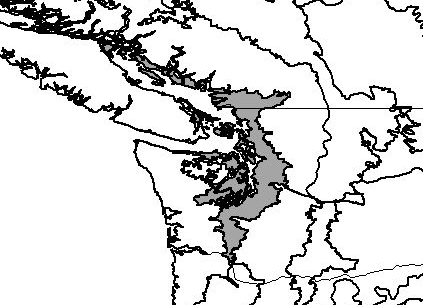
Tacoma Narrows, Washington (c) 2005 Steven J. Baskauf
Bioimages home (click on an image to enlarge)
view
this page in its intended navigation context
Puget lowland forests
(WWF
ecoregion NA0524)

Tacoma Narrows, Washington
(c) 2005 Steven J.
Baskauf

Source of bioregions data:
Olson, D. M. and
E. Dinerstein. The Global 200: Priority ecoregions for global conservation. (PDF
file) Annals of the Missouri Botanical Garden 89:125-126.
Distinctiveness (1=highest,4=lowest): 4
(nationally important)
Rain shadow effects of the Olympic Mountains have produced widely ranging
rainfall across the ecoregion. Thus there are coniferous forests, oak
groves, prairies, and swamps.*
Conservation Status (1=most endangered, 5=most
intact): 1 (critical)
Only 5% of the original habitat remains and it is heavily altered.
This region lies in the most heavily populated area of Washington and British
Columbia. Urbanization and agriculture are major threats to the remaining
habitat.*
 | Thuja plicata | (western red cedar) |
 | Abies grandis | (grand fir) |
Polystichum munitum (sword fern)
 | Tsuga heterophylla | (western hemlock) |
 | Pseudotsuga menziesii | (Douglas fir) |
 | Quercus garryana | (Oregon white oak) |
 | Cornus nuttallii | (Pacific dogwood) |
 | Arbutus menziesii | (Pacific madrone) |
 | Pinus ponderosa | (ponderosa pine) |
 | Pinus contorta | (lodgepole pine) |
 | Pinus monticola | (western white pine) |
 | Gaultheria shallon | (salal) |
Juniperus scopulorum (Rocky Mountain juniper)
 | Populus tremuloides | (quaking aspen) |
Betula papyrifera (paper birch)
Associated habitats
Because of development and logging in this ecoregion, it is difficult to
locate examples of undisturbed habitats.
Coast, Tacoma Narrows, Washington


(c) 2005 Steven J.
Baskauf hires
hires
Commercial forest, U.S. 101 and Rt. 104, Olympic Peninsula, Washington


Left: mixed forest of Acer macrophyllum (bigleaf maple), Abies grandis
(grand fir), Thuja plicata (western red cedar), and others. Right:
commercial logging operation
(c) 2005 Steven J.
Baskauf hires
hires
Mixed forest fragment, Skagit River valley, Skagit Co., Washington


(c) 2005 Steven J.
Baskauf hires
hires
Roadside, Tacoma, Washington

Prairies were once present in Tacoma, but they have been largely destroyed by
urbanization.
(c) 2005 Steven J.
Baskauf hires
Dry forest, Port Angeles, Olympic Peninsula, Washington

In the rain shadow on the northeast side of the Olympic Mountains, annual
rainfall can be as low as 40 cm per year, in stark contrast to the 500 or more
cm of rainfall of the lush rainforests on the western side
of the mountains.
(c) 2005 Steven J.
Baskauf hires
* Ricketts, T.H., E. Dinerstein, D.M. Olson, C.J. Loucks, et al. (1999) Terrestrial Ecoregions of North America: A Conservation Assessment. World Wildlife Fund - United States and Canada. Island Press, Washington, D.C. pp. 225-227.
Except as noted, images copyright 2002-2005 Steve Baskauf - Terms of use